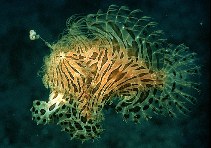| Family: |
Antennariidae (Frogfishes) |
| Max. size: |
25 cm TL (male/unsexed); max.weight: 32.9 g |
| Environment: |
reef-associated; brackish; marine; depth range 10 - 219 m, |
| Distribution: |
Eastern Atlantic: off the African coast, from Senegal to Southwest Africa, with a single record from St. Helena. Western Atlantic: off the coast of New Jersey (USA), Bermuda, Bahamas, Gulf of Mexico and throughout the island groups of the Caribbean to the southernmost coast of Brazil. Indo-Pacific: Red Sea and the East African coast to the Society and Hawaiian islands, north to Japan, south to Australia and New Zealand.
Not in Eastern Pacific (Ref. 123477 ver. 09Nov2021). |
| Diagnosis: |
Dorsal spines (total): 3-3; Dorsal soft rays (total): 11-12; Anal spines: 0-0; Anal soft rays: 7-7. Diagnosis: body short and globose; mouth large with many small, villiform teeth; skin rough, covered with bifurcate dermal spinules; pectoral-fin lobes attached to sides of body; illicium at most as long as second dorsal-fin spine; head, body and fins entirely covered with rough, parallel, dark streaks (Ref. 57225).
Description: characterized by having unbranched pelvic rays except posteriormost bifurcate (Ref. 90102). Illicium about as long as (Ref. 57225) or slightly longer than second dorsal spine (Ref. 90102). Esca with 2-7 worm-like appendages; membrane connects second dorsal fin to head; hair-like filaments covering head, body and fins (Ref. 90102). Shape of lure variable from short and thick to long and slender; illicium attaining 13.6-22.7% of SL; second dorsal-fin spine more or less straight and attains 11.4-19.0% of SL; third dorsal-fin spine curved backwards, attaining 16.7-29.3% of SL; eye diameter 3.5-7.4% of SL (Ref. 57225). Bone supporting illicium extends in front of upper lip (Ref. 26938). Length usually to about 20 cm, but occasionally larger in subtropical zones (Ref. 48635).
Coloration: color variable, often light yellow, orange, green, gray or brown (Ref. 26938, 57225), sometimes solid black (Ref. 26938) or almost white (Ref. 57225). Bands or large, elongate brownish or black spots; preserved specimens beige, yellow, orange, brownish or black (Ref. 57225). Prominent lines radiate from eye (Ref. 26938). |
| Biology: |
Inhabit rocky and coral reefs, on rocks, sand or rubble (Ref. 9710). Found in weedy estuaries along the east coast of southern Africa (Ref. 4113). Occurring in marine or brackish waters (Ref. 57225). In the Atlantic, it is found at an average depth of 40 m (Ref. 5288). Benthic (Ref. 58302). Observed to inflate itself greatly like the puffers (Ref. 5521). Oviparous. Males have more intense coloration and extended cutaneous appendages than females (Ref. 205). Eggs are bound in ribbon-like sheath or mass of gelatinous mucus called 'egg raft' or 'veil' (Ref. 6773). |
| IUCN Red List Status: |
Least Concern (LC); Date assessed: 09 May 2013 Ref. (130435)
|
| Threat to humans: |
harmless |
Source and more info: www.fishbase.org. For personal, classroom, and other internal use only. Not for publication.

